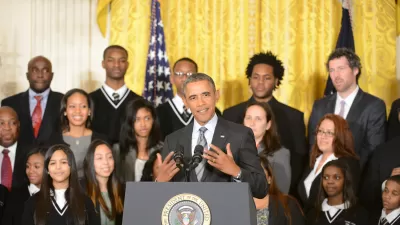With the national Promise Zone grant initiative rolling out in Los Angeles, the Youth Policy Institute aims to deploy funds strategically in targeted areas that struggle with poverty.
(Updated 5/13/14) When the White House announced the first five Promise Zones in the nation—areas that would receive federal grant funding to implement place-based approaches to fighting poverty—and Los Angeles was declared among them, the city and its partners prepared to maximize the remarkable $500 million opportunity. This transformative sum of money would be utilized with a close eye to metrics, and participating organizations agreed on shared outcomes they would seek. With special attention to the power of schools as centers of communities, these entities crafted programs they hoped would improve academic achievement and increase incomes.
The Youth Policy Institute, led by Dixon Slingerland, serves as the point organization for Promise Zone implementation in LA’s selected neighborhoods. Slingerland laid out the theory of change behind the Obama Administration's initiative in a conversation with The Planning Report, articulating what he hopes the Promise Zone will accomplish in Los Angeles, the obstacles to getting there, and the measures by which Angelenos should judge success.
Slingerland explains, "What we have found is that if you go into a school as part of a community-based strategy and saturate that school and surrounding neighborhood with resources, and turn that school into a community hub, then there are dramatic increases in academic achievement.”
Correction: An earlier version of this post incorrectly stated the Promise Zones funding as $50 million.
FULL STORY: The Promise of the Obama Administration’s LA Promise Zones

Planetizen Federal Action Tracker
A weekly monitor of how Trump’s orders and actions are impacting planners and planning in America.

Restaurant Patios Were a Pandemic Win — Why Were They so Hard to Keep?
Social distancing requirements and changes in travel patterns prompted cities to pilot new uses for street and sidewalk space. Then it got complicated.

Map: Where Senate Republicans Want to Sell Your Public Lands
For public land advocates, the Senate Republicans’ proposal to sell millions of acres of public land in the West is “the biggest fight of their careers.”

Maui's Vacation Rental Debate Turns Ugly
Verbal attacks, misinformation campaigns and fistfights plague a high-stakes debate to convert thousands of vacation rentals into long-term housing.

San Francisco Suspends Traffic Calming Amidst Record Deaths
Citing “a challenging fiscal landscape,” the city will cease the program on the heels of 42 traffic deaths, including 24 pedestrians.

California Homeless Arrests, Citations Spike After Ruling
An investigation reveals that anti-homeless actions increased up to 500% after Grants Pass v. Johnson — even in cities claiming no policy change.
Urban Design for Planners 1: Software Tools
This six-course series explores essential urban design concepts using open source software and equips planners with the tools they need to participate fully in the urban design process.
Planning for Universal Design
Learn the tools for implementing Universal Design in planning regulations.
Heyer Gruel & Associates PA
JM Goldson LLC
Custer County Colorado
City of Camden Redevelopment Agency
City of Astoria
Transportation Research & Education Center (TREC) at Portland State University
Camden Redevelopment Agency
City of Claremont
Municipality of Princeton (NJ)



























